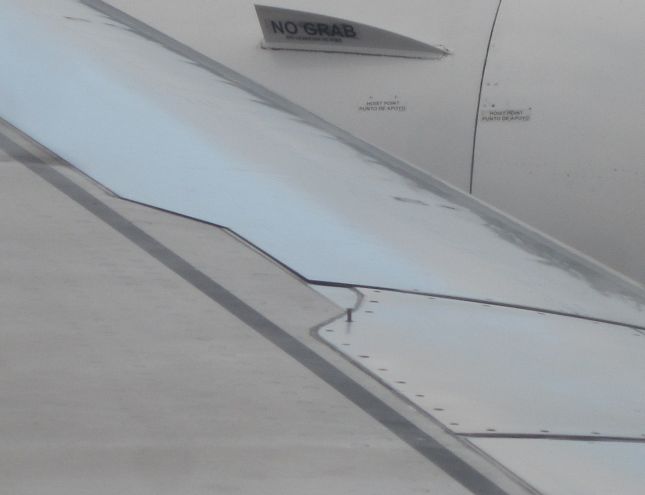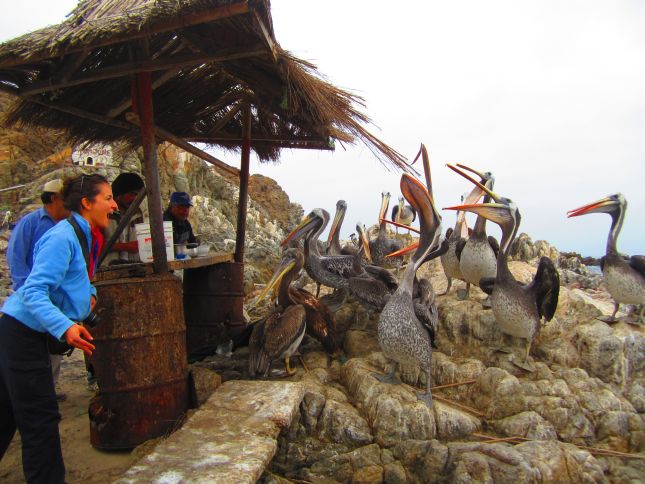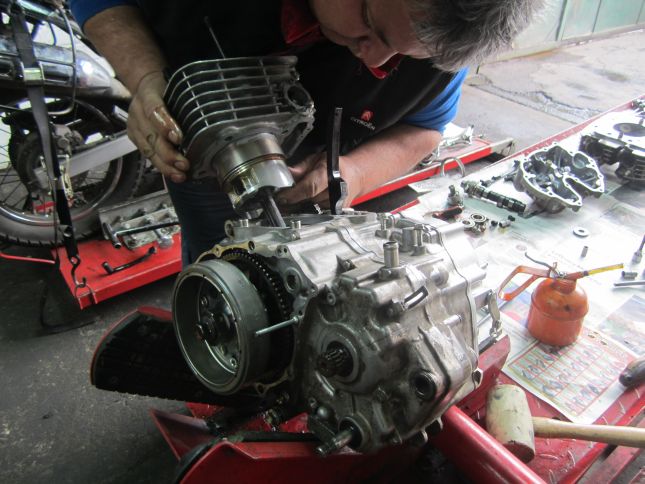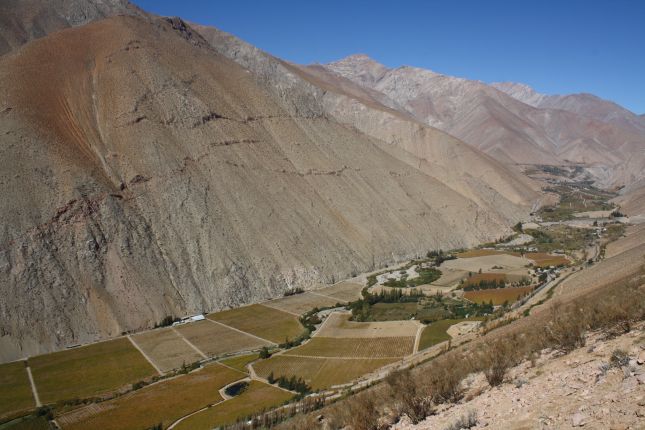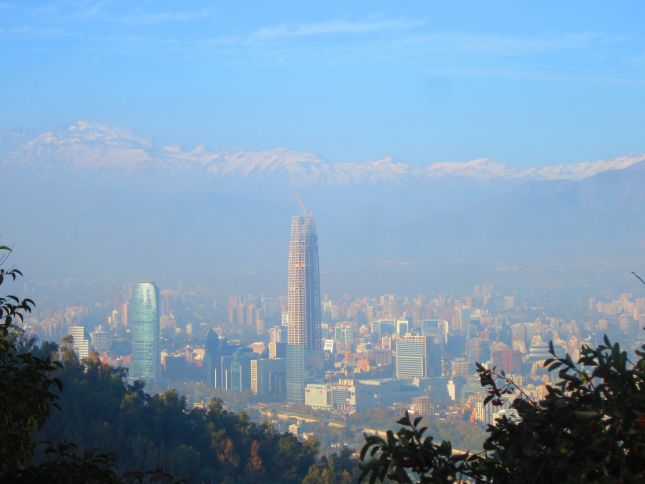
Landed in South America: Santiago, Chile
Hello friends and fellow crunchers!
You may be wondering what has happened to us, with no further updates hitting the blog. Well, I have to admit we have been rather neglectful of our blogging duties. The photo-sorting work, which we have been doing (Ebru has been doing), has alone been enough to keep us busy. And with all the driving and sight-seeing in Australia and New Zealand, as well as the blissful relaxing, snorkelling and diving on waylaid Pacific islands of Vanuatu and Fiji, you can understand that there has just been not enough time to catch up!
Well, now we’ve finally arrived in Chile and a different pace of life has begun. I think we’re going to enjoy South America!
Our experience in Chile has been unforgettable.
Santiago. Our easy public (CentroPuerto) bus transfer from the airport to the city centre (only 400Pesos/pp) works perfectly. A short, paranoid walk and we arrive at our Hostel, Don Santiago without issue. Don Santiago belongs to a guy called Pato and is run by him and a handful of other staff, all of them brilliant people. The setup is great and the breakfast included is the best we find anywhere. Pato’s even managed to find a steady supply of Marmite and Vegemite to save some foreigner groups from cold turkey. We quickly fall in love with the place and our initial booking of two nights extends into eight. We meet a load of wonderful people there during our stay.
Pablo and Mauricio introduce us to the Chilean Hip Hop scene, which is booming, and Bruno the Brazilian teaches us BBQ Brazilian style with ample Caipirinha to accompany and we promise to come visit him in Bello Horizonte. See our Don Santiago review in Tripadvisor here!
As always in foreign countries, be aware that what you read doesn’t always mean what it seems..
Here in Chile, self catering in the hostel as we are, we can get by on about 5000Pesos(/2ppl) a day for food, including a magnum sized bottle of wine (2000Pesos). A litre of beer (Escudo is the best) is about 900 Pesos if you get the returnable bottles. Meat and cheese and bread (all good around here) we buy in the little corner markets as the quality tends to be better and we prefer it’s nicer than buying in the supermarket (the main ones being SantaIsabel and Unimark). Keep in mind that Sundays most shops are shut or shut early.
To remedy our initial South America paranoia, we soon find out Santiago people are great. Friendly, helpful, welcoming. This seems to be the case for the rest of Chile too, in our experience (except the extreme North). Chile is not cheap, but a great country to visit if you’re in South America. For reasons many people believe to be owing to the Pinochet regime, the economy here has done much better than most of South America and it seems that has brought with is some positive aspects in peoples’ attitude and quality of life. I find it really puzzling that people are still reeling from the shock of that tyrannical dictatorship (installed by the USA, once again) which led to the torture/murder/disappearance of thousands, yet there seems to be some kind of consensus that it put them on a better economic foundation. The Memory Museum – which deals with this gruesome episode- on is an interesting visit, yet less enlightening than expected, since 99% of the entire exhibition is in Spanish with no translation.
People seem to be very anti police but respect the rule of law – then maybe that’s because nobody wants to have a run in with the police here. Protests happen frequently and mostly end with flying stones (we nearly got hit driving through the town one day), tear gas and water canons. Largely these demonstrations seem to be about getting free education, as far as I could tell.
Sight seeing: To get around, the first thing you’ll do here is get one of the tourist maps, available in every hotel/hostel. That’s really all you need because all the main places are marked one them.
If you see the big hill with the virgin Mary atop it, you know where the Bellavista area is. This is a vibrant district full of bars, restaurants, cafes and craft shops, well worth a visit. (If you go on Sundays expect to see most things shut!) While you’re there take a 20 minute walk (or if you’re not a walker, a 5 minute cable car) to the top of the hill, see some churches and get a view of the entire city bowl and surrounding mountains. Good photography can be a challenge though because of all the smog in the air.
You can visit a zoo and a whole complex up there but we didn’t do that. But more interesting in my opinion is the Pablo Neruda House museum, which is at the base of the hill. This is something many people do and enjoy, but I would highly recommend spending some time in the shop at the entrance, because that’s where you’ll be able to browse through some of his books and read a bit of his beautiful poetry, which is really what he’s famous for – not for his house!
Many more museums to visit, but if you’re a museum person you’ll have checked these out online already, otherwise they’ll be on the tourist map.
As for the central market, plenty of seafood to buy there but we avoided the main dining market inside as it smelt strongly of tourist trap – the setting, the serenading musicians, the restaurant keepers flocking to get you seated at their stall… For a more authentic experience take your chances at one of the little restaurants on the outside of the building – you’ll be sure to attract astonished looks.
Also if you want see a great market, exit the Mercado Central and head directly north, across the river. Here you will find a market complex too big to comprehend, selling all the fresh and dried foods you could wish for. The first building looks like a parking garage, has many market stalls and many little restaurants at the top floor where you can pick up a good meal for a bargain. But out back (North) the complex goes on and on, almost all the way to Bellavista!
There’s a simple metro system to navigate in Santiago, which is reasonably priced, normally 600Pesos/pp/trip, but this varies according to whether you travel low or peak hours. However I would recommend walking as much as possible.
If you’re moving around the centre of town you’re not likely to have problems – that is pretty much everything you see on the tourist maps. Locals warn that you need to take very good care of your belongings – if you don’t know this you’ll learn soon enough, anywhere in the world – and that there are barrios on the outskirts of the city which are a bit dangerous, but you’re unlikely to go there for any reason anyway. There’s a lot of beautiful old architecture in this city and some very creative graffiti.
And of course you wouldn’t want to miss a sneaky churrasco and a bottle of beer in some out-of-sight little bodega along the way. When on foot, watch out for dog poo everywhere! Though the dogs themselves are as friendly as the folk you meet. They seem to have a special status around here, lazing around like corpses in the middle of the way, unlikely to move for anything except a food donation.
A big attraction here is of course a visit to a wine farm, most popularly the famous Concha y Torro. We go there by metro (easy, go to the final stop [Puente Alto or Las Mercedes] on the L4 [Blue] line) and then catch a taxi or collectivo to the wine estate itself. At the entrance we’re offered two tour options, one for 8000Pesos, including two tastes of wine; the second for 15000Pesos with five tastes and a cheese board included. All wines you taste are selected by the house and both let you take home the engraved CyT wine glass, but if you’re backpacking you’ll probably leave this behind at your hostel anyway (excellent, because good wine glasses don’t go amiss there). Our suggestion would be to save your money for cheeses from the local market – the cheese board is just a sales gimmick.
The tour through the estate and the cellar is interesting, informative and well organized. The tour gives details about the estate history, leads past the estate houses and into the legendary Casillero del Diabolo cellar. But in the end I’m somewhat disappointed. What I envisaged (apart from taking a tour) is to be able to do some wine tasting: to have a range of bottles available to be able to taste from at the cellar bar, someone at hand to discuss or make recommendations, then to be able to buy those I like to take home with me. The format here is totally tour focussed: you take a tour, go to the “souvenir” shop to buy either the wines you’ve tasted (mostly the same budget line and vintage) or others you know nothing about, then go home. You can buy wine by the glass at the on site restaurant at restaurant prices, but that’s not tasting in the same sense and a glass will set you back the same as a cheap bottle.
For the biggest producer in the region I think this is rather poor. Surely with the hundreds of hectares in production and their extreme international success, a few litres a day would not go amiss to provide a more traditional experience. Isn’t that what it’s all about? I would even pay a couple of dollars to just do a wine tasting visit, without the tour. I feel like, apart from the tour which was good, I might as well have gone to a wine bar or supermarket.
One item I must mention: if you’re ever near a theatre and they mention an act called “Camino Animal” or “Adhesion Voluntaria”, find out when and where it’s happening and be there. We were lucky enough to encounter this performance free of charge at the main Santiago theatre (GAM) and we found it awesome. A worm-like procession of actors morph their way through the hall in harmony with the vibrations of ambient music played by a single woman on some instruments I cannot name. The info I saw on the poster is: “Gabinete Presenta; Camino Animal; de Simon Pascal; Adhesion Voluntaria”.

